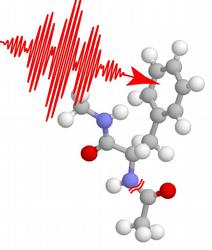The work of our group focus on the investigation of photoinduced electronic and geometric changes of complex molecular systems and clusters using synchrotron and Free-Electron Laser (FEL) light as well as table-top femtosecond (fs) laser technology in a broad spectral range. This field of ultrafast spectroscopy was pioneered by A. Zewail in the late 1980th. The "Holy Grail" of our research would be to follow, manipulate and possibly control the motion of electrons and atomic particles in real-time during the formation and rearrangement of atomic orbitals, molecular bonds and band structure under natural or extreme conditions.
Many processes occurring in nature upon electronic excitation, such as photostability of DNA, isomerization and microsolvation dynamics proceed on ultrafast timescales. A detailed knowledge on the basic photophysical and photochemical processes is still rather limited even in small molecular building blocks of biological relevance in the gas phase.
The group pursues prototypical studies on C60 fullerenes but also on more complex biological samples, e.g. protected amino acids, small peptides and embedded biomolecules or clusters with a particular solvation shell such as water. These gas phase studies aim to mimic photoinduced processes in natural environment on the molecular scale which bridge the gap to experiments in solution.
The combination of state-of-the-art methods in nonlinear optics (femtosecond pump-probe spectroscopy, pulse shaping, coherent control) and modern detection schemes such as dynamical imaging of electrons and ions with the worldwide unique power of FEL light at short-wavelength allows to follow (control) excitation, bond breaking and formation, ionization and fragmentation directly in space and time. Aside from time-resolution on the order of nuclear motion ionizing radiation such as XUV, soft and hard X-rays give information on the local electronic and geometric structure and chemical composition of matter.
Towards the goal of controlling the molecular response strong-field physics of small model systems provides the basis in order to understand complex correlations and couplings between various degrees of freedom for electronic and nuclear motion in many-particle quantum systems. The investigation of the interplay between dynamical and structural properties draws a rather complete picture of photophysical and photochemical processes in molecular systems and clusters paving the way for new applications and future challenges such as optically controlled organic chemistry.
The dream is to reveal the changing structure of biomolecules during an ongoing ultrafast chemical reaction, or in other words to record the molecular movie in real time. This endeavour is in the spirit of Francis Crick, one of the discoverers of the DNA molecule structure, who once said: “If you want to understand the function, study the structure”. In fact, since structure, function and dynamics of complex molecular systems are closely linked together one may even dream of judiciously tailoring function, by controlling electron and nuclear dynamics on the picosecond to attosecond timescale using ultrafast lasers.






